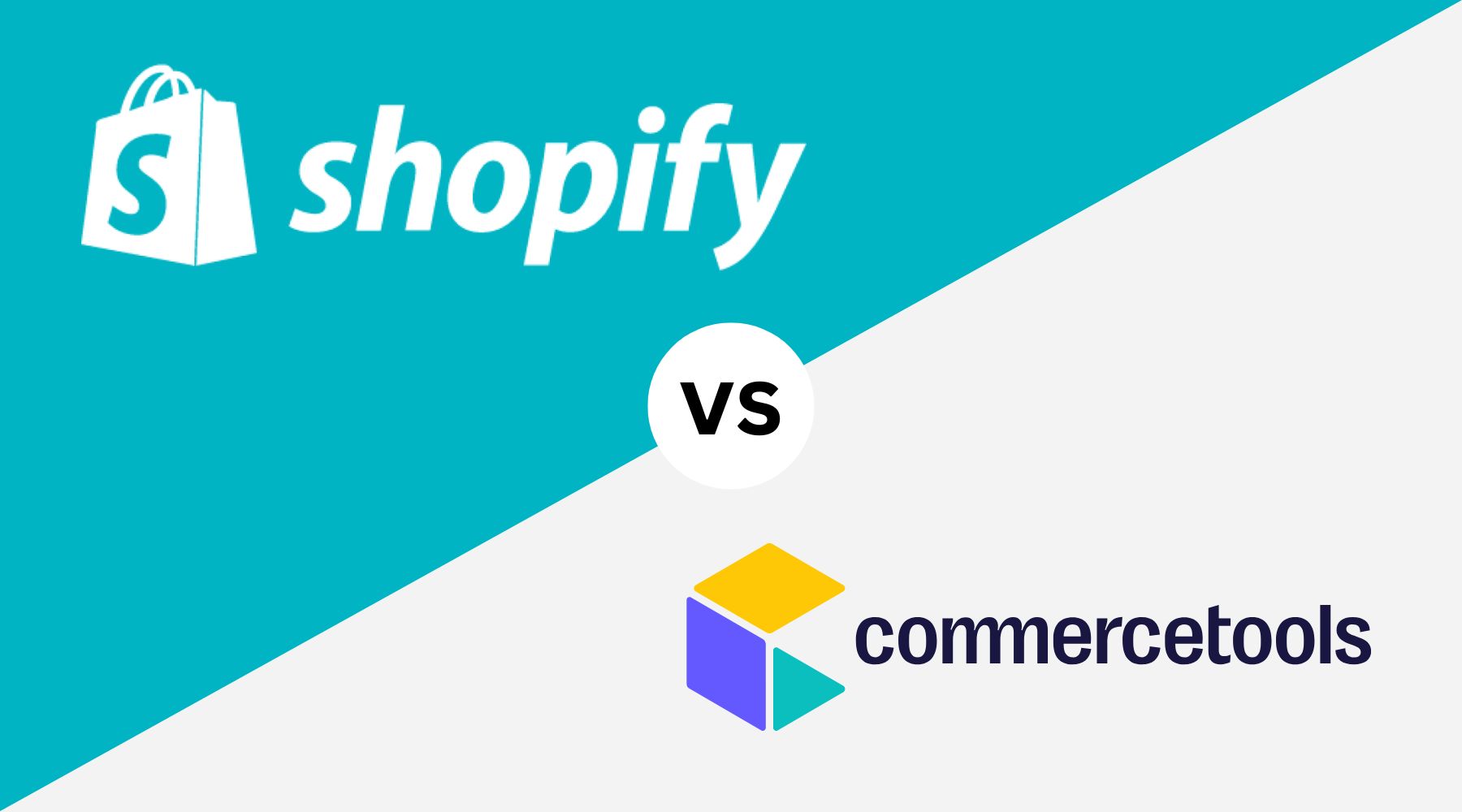When it comes to building, scaling, and future-proofing an online business, Shopify and Commercetools stand out as two of the most recognized players in digital commerce. Each platform has carved out a distinct niche in the market. Shopify known for its fast time to market and ease of use, Commercetools praised for its modular flexibility and enterprise-grade architecture.
But which one is right for your business?
This comparison is for decision-makers in mid-sized to large companies, tech leads, eCommerce managers, and anyone considering a switch or looking for a future-ready commerce platform.
Whether you're scaling your B2C brand, building workflows, or exploring composable commerce for omnichannel growth. This article will walk you through the strengths, trade-offs, and critical differences between Shopify and Commercetools.
Let’s break it down.
9 Key Comparison Areas Between Shopify and Commercetools
To make an informed decision, it’s essential to look at the platform fundamentals side by side. The following sections dive into the nine most relevant criteria for evaluating Shopify vs Commercetools.
1. Pricing & Fee Structure
When comparing Commercetools and Shopify, the pricing models reflect two fundamentally different philosophies. Shopify operates on a SaaS-based pricing model, which includes monthly subscription fees depending on the selected plan (Basic, Shopify, Advanced, Plus).
In addition to the base fee, the provider applies transaction fees unless Shopify Payments is used, and optional apps or third-party integrations may introduce recurring hidden costs. This setup is straightforward but can lead to a growing total cost as your business scales.
Commercetools follows a composable pricing model designed with enterprise users in mind. Instead of fixed packages, pricing is determined by API consumption, order volume, and selected service integrations.
This model can seem complex upfront, but it eliminates the hidden costs often associated with GMV-based platforms. Over time, this structure can offer significant advantages in terms of cost control and long-term profitability.
If you’re analyzing your options from a scalability and cost-efficiency standpoint, Shopify offers speed and simplicity, but Commercetools delivers better long-term TCO (Total Cost of Ownership) through architectural freedom. Learn more about the strategic pricing benefits in our article on the advantages of Shopify Plus.

2. Ease of Setup & Flexibility
One of Shopify’s strongest advantages lies in its ease of use. Setting up an online store can be completed in just a few hours thanks to its template-driven UI, drag-and-drop editors, and out-of-the-box functionality. This simplicity is ideal for startups and small teams who want to avoid complex development cycles.
However, for enterprises with multiple storefronts, custom workflows, or localized customer journeys, Shopify’s pre-packaged structure may become a constraint.
Commercetools takes a different approach. As a headless commerce platform built for composability, it allows brands to build exactly what they need from scratch or through best-in-class tools. While this increases the initial setup effort, it ensures limitless adaptability for future needs.
If your business needs quick setup with reasonable flexibility, Shopify is the obvious choice. But if you're building a commerce architecture for long-term innovation, Commercetools stands out.
We help clients integrate composable solutions quickly. Learn how in our guide to Shopify Plus development services.
3. Architecture & Scalability
Shopify is a powerful solution for small to mid-sized businesses, but its architecture has limitations. It’s essentially a monolithic system, even on Shopify Plus, and while it supports apps and APIs, the underlying structure restricts deep customizations. During traffic surges or complex data syncing, this can become a bottleneck.
Commercetools is built on MACH principles: Microservices, API-first, Cloud-native, and Headless. This modular architecture makes it highly scalable, resilient, and future-proof. Enterprises can independently deploy services, support global storefronts, and accommodate unpredictable traffic peaks without impacting performance.
For those exploring high-performance enterprise architecture, Commercetools leads the way. But to understand when Shopify’s monolith still makes sense, especially for DTC brands, see our breakdown in Shopify Plus vs Magento.
4. B2B & D2C Capabilities
As ecommerce becomes more hybrid, brands need platforms that support both B2B and D2C models.
Shopify has recently introduced native B2B features:
- custom pricing,
- customer-specific catalogs, and
- net payment terms.
However, these features remain limited when scaling across multiple buyer types or complex workflows.
Commercetools is engineered for multi-model selling. It includes advanced B2B APIs, self-service portals, role-based access, and pricing engines. Whether you're running D2C sites, B2B buyer journeys, or a combination of both, Commercetools provides a single, composable foundation to manage them all.
If you're trying to serve multiple buyer types with Shopify, friction is inevitable. For brands managing complex operations, the comparison with Zoey sheds light on what’s possible. Explore more in our article on Zoey vs Shopify Plus.

5. Sales Channels & Omnichannel Reach
Shopify offers seamless integration with marketplaces like Amazon and eBay, as well as with social platforms such as Instagram, Facebook, and TikTok. Its POS solution is deeply integrated into the Shopify ecosystem, making it ideal for retail brands seeking a hybrid sales setup.
Commercetools enables omnichannel strategies as well, but in a more flexible and customized way. Brands can implement their own POS systems, integrate custom marketplaces, and localize experiences for each region or storefront. With Commercetools, digital and in-store experiences merge through API-based architecture rather than predefined features.
Omnichannel success requires agility and precision—especially when your business spans multiple countries or physical locations. To see how we help clients build flexible omnichannel environments, visit our Shopify Plus development agency page.
6. Ecosystem & Integrations
Shopify’s app marketplace is vast, giving users access to thousands of pre-built tools for email marketing, reviews, product filters, shipping, analytics, and more. However, heavy reliance on third-party apps can lead to fragmentation and performance issues at scale.
Commercetools relies on a strong ecosystem of integration partners and custom-built APIs. Instead of searching for an app, businesses use Commercetools' composable logic to build custom solutions that match their workflow. ERP, PIM, CRM, and custom middleware can be directly embedded into the commerce logic.
For enterprises that prioritize architectural cohesion and flexibility, Commercetools is often the better fit. But Shopify’s structured ecosystem still delivers results, especially for mid-sized teams. Learn more about when to choose which in our article on choosing the right Shopify Plus agency.

7. Marketing & SEO Capabilities
Shopify provides out-of-the-box tools for SEO, including automatic sitemaps, meta tag control, clean URLs, and blog integration. It also supports email automation, customer segmentation, and analytics through native and third-party apps. For fast-growing D2C brands, this turnkey setup is hard to beat.
Commercetools, while not offering native SEO tools, excels by giving brands total control over their tech stack. Marketers can choose specialized CMS platforms, CDPs, and analytics solutions, ensuring full ownership of their content and customer data. This flexibility enables more granular personalization and SEO strategy.
If content marketing and SEO are key drivers in your growth, both platforms have merit, just in very different ways. Dive deeper into this comparison in our article Shopify Plus vs NetSuite.
8. Checkout & Conversion Optimization
The Shopify checkout is widely regarded as one of the most streamlined in ecommerce. It’s fast, mobile-first, and comes with key features like express checkout, auto-filled fields, and built-in trust signals. However, only limited customization is allowed, unless you're on Shopify Plus and using these Functions.
Commercetools allows you to build a fully customized checkout from scratch. From field logic to UX layout, payment orchestration, and multi-step flows, every detail can be adapted to your funnel goals. This flexibility is critical for brands that rely heavily on conversion testing and checkout optimization.
If you need full control over the user experience, Commercetools delivers. But if you want fast deployment with proven performance, Shopify remains a top-tier option. Explore the limitations and strengths further in our piece on Shopify Advanced vs Shopify Plus.
9. Security, Compliance & Support
Both platforms meet international security standards, including PCI-DSS and GDPR. Shopify offers fully managed infrastructure with 24/7 support, uptime SLAs, and secure data hosting. For leaner teams, this can be a huge advantage.
Commercetools, meanwhile, provides more control over security configurations and data residency. With premium support packages, dedicated technical onboarding, and 99.99% uptime options, it's built for enterprise compliance across global markets.
When security, data sovereignty, and SLA commitments are key decision criteria, Commercetools has the edge. But Shopify’s simplicity and trusted reputation remain strong. Learn how to evaluate CRO-readiness and support levels in our guide to Shopify Plus CRO Services.

Shopify Plus vs. Commercetools: Key Comparison
The table below summarizes all key criteria making it ideal for businesses seeking a solid yet efficient decision-making foundation.
|
Category |
Shopify Plus |
Commercetools |
|
Pricing & Fees |
Predictable pricing based on GMV; scalable with business growth |
Transparent order-based pricing; flat and capped for large-scale operations |
|
Ease of Setup & Flexibility |
Fast setup with pre-built templates; easy onboarding for teams |
Requires technical setup; highly flexible with composable architecture |
|
Architecture & Scalability |
Proven cloud performance; handles traffic spikes reliably |
MACH architecture; designed for large-scale enterprise workloads |
|
B2B & D2C Capabilities |
Strong D2C features; expanding B2B support with APIs and apps |
Built-in B2B support; advanced customization for complex business models |
|
Sales Channels |
Native omnichannel: POS, social, marketplaces, online |
APIs support all channels; in-store often needs separate solutions |
|
Ecosystem & Integrations |
Extensive app marketplace and partner network; ERP/CRM ready |
Composable integrations via APIs; partner-led implementations |
|
Marketing & SEO |
Built-in tools, content editing, fast load speeds, full SEO control |
Developer-led personalization; content depends on integrations |
|
Checkout & Conversion |
High-converting UX; mobile-first checkout; customizable and fast |
Requires custom frontend; more control, but higher dev complexity |
|
Security & Support |
PCI-compliant, GDPR-ready; strong support, 24/7 help and active community |
SLA-backed uptime; premium support via Commercetools experts |
Who Is Commercetools vs Shopify Best For?
Choosing the right commerce platform depends on your business model, team size, growth stage, and technical requirements. The following overview helps you understand which solution aligns best with your needs.
|
Criteria |
Commercetools |
Shopify |
|
Enterprise-level scalability |
✅ Built for high complexity |
✅ With Shopify Plus |
|
Fast time-to-market |
❌ Longer setup, high developer input |
✅ Quick launch with templates |
|
B2B eCommerce |
✅ Native support, flexible APIs |
✅ Basic via Shopify B2B (Plus) |
|
Composable architecture (MACH) |
✅ Fully composable & headless |
❌ Limited composability |
|
SMB readiness |
❌ Not designed for small teams |
✅ Ideal for small and mid-sized |
|
Low-code / no-code setup |
❌ Requires experienced dev team |
✅ Intuitive admin & no-code tools |
|
Industry-specific solutions |
✅ Strong in complex verticals |
✅ Broad but more general |
|
Global expansion tools |
✅ Multi-brand, multi-region ready |
✅ Multi-currency & multi-language |
|
Cost transparency & simplicity |
✅ Order-based pricing |
✅ Simple pricing with known fees |
Key Takeaways:
- Commercetools is best suited for large enterprises, digital-native brands, or companies with highly complex commerce needs that require deep customization and robust B2B workflows.
- Shopify is ideal for small to mid-sized businesses looking to grow fast with a powerful, user-friendly platform. Shopify Plus extends this flexibility to larger brands with dedicated support, faster checkout, and greater control.








